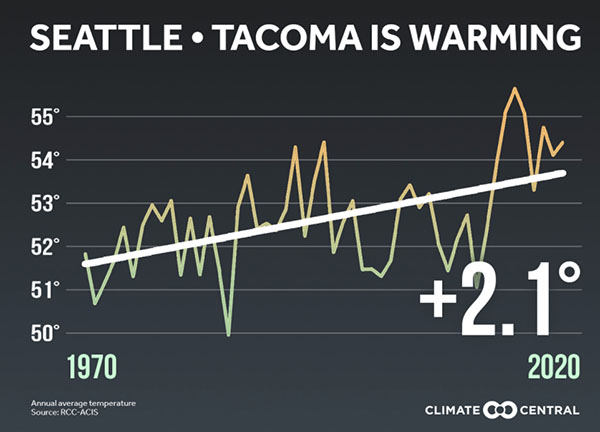Earth Day launches new climate column by Steve Bernheim
||| CLIMATE EYES BY STEVE BERNHEIM, theORCASONIAN OP-ED REPORTER |||
Local TV weather announcers couldn’t be happier: record high temperatures and sunshine in April.

Viewers seem unconcerned, even giddy. On these warm sunny days, Orcas Island can seem far from a climate emergency.
But the region’s heat is increasing because of the increasing concentration of carbon dioxide (CO2) and other greenhouse gases in the earth’s atmosphere causing the weather and the oceans to heat up. Anyone can monitor CO2 levels in the atmosphere and they have been consistently increasing, year over year, as more greenhouse gases are released into the atmosphere. Efforts taken by the world’s scientists, nations, leaders, organizations, towns and all other occupants have so far been unable to stop this heat-inducing increase on earth.
Though different parts of the world face different climate threats, the University of Washington has concluded that local threats include disappearing shorelines, less snowpack, shrinking glaciers, reduced water supplies, temperature increases throughout the year, more extreme hot days, unpredictable extreme weather events, ocean acidification affecting shellfish, wildfire, and flooding from extreme rainfall. Higher ocean water levels are predicted and visualized, likely a rise of 1.6 feet to 8.3 feet of absolute sea level by 2100, locally. The problem is sufficiently dangerous such that the UW College of the Environment concludes there is no time to waste.
The State has enacted laws to eliminate coal power from the electrical grid by 2025 and transition to 100% clean energy by 2045. But it is up to our local government to enact the local laws which help to reduce greenhouse gas emissions, such as enabling alternatives to petro-powered transportation and requiring energy conservation in buildings.
Local climate action plans are proliferating elsewhere in Washington State, typically containing guidelines for mitigating and adapting to climate change, promoting sustainability and energy conservation and greenhouse gas-oriented land use planning. Most of the plans try to quantify emissions from buildings and community energy use and to answer how local land use patterns affect greenhouse gas emissions. Most plans have a transportation and alternative fuels section; some plans focus on natural systems and improved community well-being.
Most local action plans consider practical and obvious steps such as staff education, re-thinking single occupant petro-fueled transportation, banning natural gas hookups, reforming the local economy away from greenhouse gas dependence, and supporting greenhouse gas reduction lifestyles. MRSC, a policy advisor to Washington state local governments, has extensive online materials for local jurisdictions to begin tackling the climate emergency.
Beyond these steps, local governments can also mandate energy conserving construction codes, attempt to tax or regulate egregious greenhouse gas polluting activities, post education notices and warning labels on gasoline pumps informing consumers of the consequences of burning gasoline, re-route infrastructure in danger of disappearance or destruction, and prohibit destruction of or restore natural areas and resources. One city has gone to court, unsuccessfully, to sue oil companies for damages arising from the release of greenhouse gases.
At least ten Washington cities implemented Climate Action Plans more than five years ago, all involving at least some realistic effort to quantify local greenhouse gas production and then to target reduction efforts based on those results. Here’s the Bellingham Climate Action website. Here’s the Skagit County Climate Plan from 2010. Here’s the Snohomish County climate advisory committee. Here’s the Jefferson County and Port Townsend climate committees. Bainbridge Island is seeking volunteers for its Climate Change Advisory Committee. Edmonds. In 2019, Tacoma declared a climate emergency. Everett declared a Climate Emergency in 2020 and has initiated a Climate Action Plan.
Each of these counties and cities and towns analyzes the climate emergency differently, but accepts responsibility for local efforts that complement the steps taken by national and international government. In January this year, President Biden in his Executive Order on Tackling the Climate Crisis said the US will this week announce its emission reduction target in compliance with the Paris Climate accords. He asks us together to combat the climate emergency with “bold, progressive action that combines the full capacity of the Federal Government with efforts from every corner of our Nation, every level of government, and … meeting these challenges will require … substantive engagement by stakeholders, including State, local, and Tribal governments.”
President Biden, how is Orcas Island local government responding?
Three years ago, the San Juan County Council adopted a community-supported ambitious “Vision Statement” on climate change:
Our community sets an example with its response to climate change. We prepare to address the negative effects in advance before they become crises. Our community encourages voluntary efforts and enacts incentives and regulations if necessary to reduce our carbon footprint.
But there are no examples. There is no preparation. There are no voluntary efforts or incentives or regulations. There is no climate action plan. There is no climate advisory committee. Are county greenhouse gas emissions falling?
The San Juan County Planning Board is finally taking action: last month on March 19, it unanimously approved a motion to recommend that the County Council form a Climate Change Advisory Committee, as well as “to convene two or three town hall meetings to hear public input on climate change.”
When a month later last Friday Planning Commissioners Pickett and Knoellinger asked about the County Council’s reaction to the recommendation, Community Development Director Erika Shook said, “We have not forwarded that to them yet, but we will do so … because the climate advisory came after the other questions, we typically brief them, and I think we needed the minutes approved today to be able to forward those on to them and it’s also a timing issue for us, too, we typically brief them and we haven’t briefed them on this stuff yet.”









Steve,
Our county council and people, such as Community Development Director Erica Shook, who work to present them with information and options, are overwhelmed. The Charter Review Commission has a subcommittee on Climate Change. They are considering recommending that the voters of San Juan County support an elected position of Climate Officer who could focus on exploring options and presenting recommendations to our County Council and to each of us. Our choices do matter. OPALCO has programs to finance the installation of energy-saving measures that are paid back via our monthly OPALCO bills. The energy savings generally pay for the cost of the upgrades and often end up with overall savings -a win-win for our planet and for ourselves.
We need programs to show how we can reduce our impact on the planet ! Reduce our wasteful ways !!
Let’s start with the shopping bags, throw away coffee cups etc.